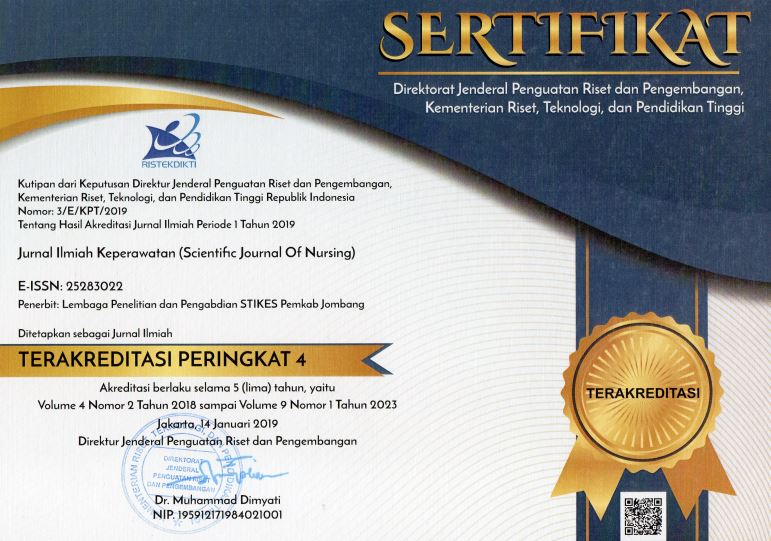STRESS PASIEN DENGAN ULKUS KAKI DIABETIKUM DI AL HIJRAH WOUND CARE CENTER JOMBANG
The Study of Stress Patients With Diabetic Ulcers in Al Hijrah Wound Care Center
DOI:
https://doi.org/10.33023/jikep.v6i1.577Keywords:
Diabetic, Foot ulcer, stress, woundAbstract
ABSTRACT
Diabetic foot ulcer is a complication of mellitus. The complication can cause psychological problems that cause stress for patient. The severity of diabetic foot ulcer will increase stress in patients. To deal with stress that needs to be overcome by reducing stress independently, besides the support system of the family is needed to help reduce stress and psychological burden. The purpose of this research is to explore how stress is experienced by diabetic foot ulcer patient.
This research is a qualitative research with phenomenology approach. Participants were diabetic ulcer who come for wound care treatments at Al Hijrah wound care center, as well as the nuclear family as additional informants. Data is taken with a thorough interview, observation.
The results obtained from two participants that stress due to diabetic ulcers is a condition related to physical and psychological conditions that cause participants to increase stress, such as: body image disorders, immobility, fear to amputation and cost difficulties.
The main effort to reduce stress is pray, read the Al Quran, dzikr and ask for help to health services in the hope that the stress can reduced independently and does not cause worse complications. It is hoped that further research will examine more deeply the stress experienced by patients with diabetic ulcers.
Downloads
References
Bus, S. A., Haspels, R., & BuschWestbroek, T. E. (2011). Evaluation and optimization of therapeutic footwear for neuropathic diabetic foot patients using in-shoe plantar pressure analysis. Diabetes Care, 34(7), 1595– 1600. https://doi.org/10.2337/dc10- 2206
Bweir, S., Al-Jarrah, M., Almalty, A.-M., Maayah, M., Smirnova, I. V, Novikova, L., & Stehno-Bittel, L. (2009). Resistance exercise training lowers HbA1c more than aerobic training in adults with type 2 diabetes. Diabetology & Metabolic Syndrome, 1(1), 27. https://doi.org/10.1186/1758- 5996-1-27
Desalu, O., Salawu, FK., Jimoh, AK., Adekoya, AO., (2011). Diabetic foot care: Self reported knowledge and practice among patients attending three tertiary hospital in Nigeria. Ghana Medical Journal. Vol 45, No 2 (2011). http://dx.doi.org/10.4314/gmj.v45i2.68930
DINKES JOMBANG. (2018). Profil Kesehatan Tahun 2018. Jombang.
Fikri, M & Nurdian, Y. (2019). Ulkus Tungkai pada Pasien Diabetes 1. Universitas Jember: Medicine Faculty
Henriksson, F. (2000), Direct medical cost patients with type 2 diabetes in Sweden. Journal of Internal Medicine. 248: 387-396. Diakses: 25 Januari 2020.
IDF. (2018). IDF 2018 Statistics. Brussels, Belgium: IDF.
Kurdi, F., & Priyanti, R. P. (2019). MANAJEMEN ULKUS KAKI DIABETIKUM: EFEKTIFITAS FOOT EXERCISE TERHADAP RISIKO DFU (DIABETIC FOOT ULCERS) PASIEN DIABETES MELLITUS DI AL HIJRAH WOUND CARE CENTER. Jurnal Ilmiah PANNMED (Pharmacist, Analyst, Nurse, Nutrition, Midwivery, Environment, Dentist), 14(2), 95-101.
Kozier, et al. (2010). Buku Ajar : Fundamental Keperawatan : Konsep, Proses & Praktik Volume 2 (Edisi 7). Jakarta : EGC.
Khrishan S,Cozier Y.C, Rosenberg L, Palmer JR. (2010). Socioeconomic Status and Incidence of Type 2 Diabetes: Results From The Black Women’s Health Study. American Journal of Epidemiology (Online) Vol 171, No. 5 Hlm. 564-570 ( http://aje.oxfordjournals.org diakses pada 25 Januari 2020).
Lestari, A.S., Warjiman, W., & Barewe, A. (2017). Gambaran Konsep Diri Pada Pasien Luka Gangren Diabetik Di Poliklinik Kaki Diabetik. Jurnal Keperawatan Suaka Insan (JKSI), 1(1), 1-10. https: //journal. Stikessuaka insan.ac.id/index.php/jksi/article/view/13
Muliawan, M., Semadi, N., Yasa, K.P. (2007). Pola Kuman dan Korelasi Klinis Ulkus Kaki Diabetikum di RSUP Sanglah Denpasar. Tesis. Denpasar: Universitas Udayana.
Nevid, Jeffrey S., Spencer. A. Rathus, dan Greene, Beverly. (2005). Psikologi Abnormal. Terjemahan Tim Psikologi Universitas Indonesia. Edisi Kelima. Jilid 1. Jakarta: Penerbit Erlangga.
Ndraha, S. (2014). Diabetes Mellitus Tipe 2 dan Tatalaksana Terkini. Depertemen Penyakit Dalam Fakultas Kedokteran Univeritas Krida Wacana Jakarta. Vol (27). No (2).
Nugraheni, D., Mabruri, IM., & Stanislaus, S. (2018). Efektivitas Membaca al-qur’an Untuk Menurunkan Stres. Jurnal Psikologi ilmiah. Volume 10, Nomor 01 http://journal.unnes.ac.id/nju/index.php/INTUISI DOAJ: 2541-2965
Ribu, L., & Wahl, A. (2004). How patient diabetes who have foot and leg ulcer perceive the nursing care they receive. http://www.internurse.com/cgibin/go.pl/library/article.cgi?uid=26578, diperoleh tanggal 3 Maret 2020
Rismayanthi, C. (2010). Terapi Insulin Sebagai Alternatif Pngobatan Bagi Penderita Diabetes. Jurnal Medikora. Vol VI, No 2. November 2010 Hal: 29-36
Saydah, S., & Lochner, K. (2010). Socioeconomic Status and Risk of Diabetes-Related Mortality in the U.S. Public Health Reports, 125(3), 377–388. https://doi.org/10.1177/003335491012500306
Vileikyte, L., Peyrot, M., Gonzalez, J.S. et al. (2009). Predictors of depressive symptoms in persons with diabetic peripheral neuropathy: a longitudinal study. Diabetologia 52, 1265–1273. https://doi.org/10.1007/s00125-009-1363-2
Waspadji S., 2009. Buku Ajar Penyakit Dalam: Kaki Diabetes, Jilid III, Edisi 4, Jakarta: FK UI pp. 1961-62.
Published
How to Cite
Issue
Section
Authors who publish with Jurnal Ilmiah Keperawatan (Scientific Journal of Nursing) agree to the following terms:
- Authors retain copyright and grant Jurnal Ilmiah Keperawatan (Scientific Journal of Nursing) the right of first publication with the work simultaneously licensed under a Creative Commons Attribution 4.0 International License that allows others to remix, adapt and build upon the work with an acknowledgment of the work's authorship and of the initial publication in Jurnal Ilmiah Keperawatan (Scientific Journal of Nursing).
- Authors are permitted to copy and redistribute the journal's published version of the work (e.g., post it to an institutional repository or publish it in a book), with an acknowledgment of its initial publication in Jurnal Ilmiah Keperawatan (Scientific Journal of Nursing).









